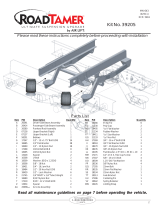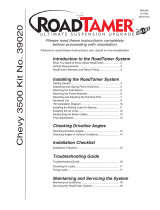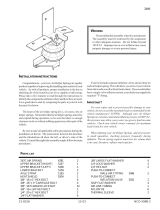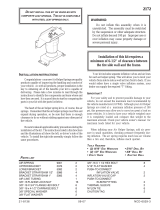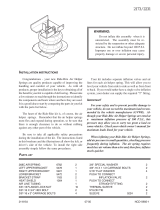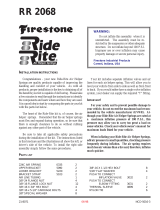Page is loading ...


2
Technical Support
1-800-248-0892
Ext. 2
Tools Needed
7/16”, 9/16” open-end or box wrenches
Crescent Wrench
Ratchet with 3/8”, 9/16” and 1/2” deep well sockets
3/8” and 5/16” drill bits (very sharp)
3/8” Nut Driver
Heavy Duty Drill
Torque Wrench
Hose Cutter, Razor Blade, or Sharp Knife
Hoist or Floor Jacks
Safety Stands
Safety Glasses
Air Compressor, or Compressed Air Source
Spray Bottle with Dish Soap/Water Solution
Before You Start
You need to determine Normal Ride Height. Normal Ride Height is the distance between the bottom
edge of the wheel well and the center of the hub with the vehicle in the “as delivered” condition. In some
cases, Normal Ride Height is not perfectly level.
Remove unusual loads and examine your vehicle
from the side to ensure it is on a level surface. If
necessary (in cases where your leaf springs are
sagging badly), use a jack to raise the rear end so
that the vehicle achieves the original “as delivered”
ride height.
Measure the distance between the center of the hub
and the bottom edge of the wheel well. This is the
Normal Ride Height. Enter the measurement
below:
NORMAL
RIDE HEIGHT: ______________ inches
IMPORTANT: Your vehicle may be equipped with a rear brake proportioning
valve. Any type of load assist product could affect brake performance. We
recommend that you check with your dealer before installing this type of product. If
your vehicle DOES NOT have a rear brake proportioning valve or is equipped with
an anti-lock type brake system, installation of a load assist product will have NO
EFFECT ON BRAKE SYSTEM PERFORMANCE.
Compressed air can cause injury and damage to the vehicle and components if it is
not handled properly. For your safety, do not try to inflate the air springs until they
have been properly secured to the vehicle.

3
Technical Support
1-800-248-0892
Ext. 2
Assembling the Air Spring Unit
LOOSELY attach the 1/8"x1/4" tube elbow fitting (O)
to the bellows. Tighten fitting finger tight plus 1
and 1/2 turns, being careful to tighten the metal hex
nut only. DO NOT OVERTIGHTEN.
LOOSELY attach the upper bracket (B) to the air
springs with two 3/8-16x7/8" hex head bolts (L),
lockwashers(N) and flat washers (M).
Attach the air spring to the lower bracket. Secure the
lower bracket (C) to the air spring with two 3/8-16x7/8"
hex head bolts (L), lockwashers(N) and flat washers
(M). Torque to 20 ft. lbs.
There is a Driver and Passenger side unit. Attach the air
spring to the inboard slotted holes of the lower bracket
with the vertical flange of the upper bracket outboard.

4
Technical Support
1-800-248-0892
Ext. 2
Attaching the Lower Bracket
Set the assembly on the leaf spring with the lower
bracket flange over the rearward u-bolt and the vertical
flange of the upper bracket on the outboard side of the
frame rail.
NOTE: On some late models, the chassis has a round
jounce bumper under the frame that will interfere with the
installation of the assembly. If your model is equipped
with this style jounce bumper, remove and discard it.
PASSENGER SIDE-It will be necessary to install the
inboard carriage bolt (D) and clamp bar (E) first before
placing the unit on the leaf spring. Install the inboard
carriage bolt through the clamp bar and up through the
lower bracket (the nut will be on the top of the bracket).
The outboard carriage bolt will go down.
DRIVER SIDE-Both carriage bolts are installed down
with the nut on the bottom of the clamp bar (opposite of
passenger side).
PASSENGER SIDE-Some models have a plastic
spacer between the leaf springs that will need to be
filed or ground away to allow the carriage bolt to be
installed into the clamp bar.
4
6
5
Round
Jounce
Bumper
Remove
and discard

5
Technical Support
1-800-248-0892
Ext. 2
Secure the carriage bolt (D) with a flat washer (K) and
3/8" lock nut (J). Tighten all fasteners to 20 ft. lbs.
Attaching the Upper Bracket
Position the upper bracket (B) on the frame rail so
that it is aligned front to rear and inboard/outboard.
Upper and lower brackets are slotted for adjustment.
Put the upper bracket back into position on the frame
rail and center punch ONE hole in the side of the
frame rail.
Tighten the rearward bolt in the upper bracket to
the air spring first. Now move the upper bracket
away from the frame and tighten the front bolt.
7
8
9
10

6
Technical Support
1-800-248-0892
Ext. 2
Drill ONE 1/2" hole in the side of the frame rail.
CAUTION - Do not drill holes into frame
before checking for hydraulic lines, gas
lines and/or electrical wires that may have
to be moved aside on either side of the
frame.
Check the alignment once again. Using the slots in
the lower bracket, align the air spring so that it is
square, vertically and horizontally to the upper
bracket.
Tighten the air spring mounting bolts to 20 ft. lbs.
Attach the upper bracket using one 1/2-13x1.5"
bolt (G), 1/2" flat washer (I), 1/2" lock washer (H)
and 1/2" hex nut (J). Only one bolt is required to
secure the bracket to the frame.
Install Other Air Spring
You have now completed the installation for one air spring. Complete steps 1-13 for the other side of
the vehicle, and then return to step 15.
11
12
13
14

7
Technical Support
1-800-248-0892
Ext. 2
Installing the Air Lines
Choose a convenient location for mounting the inflation valves. Make sure there is enough clearance
around the inflation valves for an air chuck. Drill a 5/16" hole to install the inflation valves.
The recommended location is in the wheel well or
lower body ahead of rear wheel. One on each side
provides ease of filling, checking and measuring body
height to compensate for side-to-side lean and sag.
Cut the air line assembly (AA) in two equal lengths.
When cutting or trimming the air line,
use a hose cutter (Air Lift P/N
10530), a razor blade or a sharp knife.
A clean, square cut will ensure against
leaks.
Place a 5/16" nut (GG) and a star washer (FF) on
the air valve. Leave enough of the inflation valve
in front of the nut to extend through the hole and
allow room for the rubber washer (EE), flat washer
(DD), and 5/16" nut (GG) and cap (CC). There
should be enough valve exposed after installation -
approximately 1/2" - to easily apply a pressure gauge
or an air chuck.
Do not use wire cutters or
scissors to cut the air line.
These tools may flatten or
crimp the air line, causing it to
leak around the O-ring seal
inside the elbow fitting.
Bad cut - flattened
Good cut - clean and square
15
16
17

8
Technical Support
1-800-248-0892
Ext. 2
Push the INFLATION valve through the hole and
use the rubber washer (EE), flat washer (DD) and
another 5/16" (GG) nut to secure it in place.
Tighten the nuts to secure the assembly in place.
Route the air line along the frame to the air spring
location on the leaf spring, behind the axle. Keep at
least 6" of clearance between the air line and heat
sources, such as the exhaust pipes, muffler, or
catalytic converter. Avoid sharp bends and edges.
Use the plastic tie straps (BB) to secure the air line to
fixed, non-moving points along the chassis. Be sure
that the tie straps are tight, but do not pinch the air
line. Leave at least 2" of slack to allow for any
movement that might pull on the air line.
PASSENGER SIDE ONLY - Before installing the air
line, place a thermal sleeve (HH) on the air line near
the exhaust.
Trim the excess air line before inserting it into the air
fitting. Using a standard tube cutter, a razor blade, or very
sharp knife to cut the air line. Cut off air line leaving
approximately 12 inches of extra air line. A clean square
cut will ensure against leaks. Insert the air line into the air
fitting. This is a push-to-connect fitting. Simply push the
air line into the fitting until it bottoms out (5/8" of air line
should be in the fitting). Maintain a smooth bend from
the air spring. Do not kink the air line.
18
19
20

9
Technical Support
1-800-248-0892
Ext. 2
Checking for Leaks
Inflate the air spring to 60 p.s.i. Spray all connections and the inflation valves with a solution of 1/3 dish soap
and 2/3 water to check for leaks. You should be able to spot leaks easily by looking for bubbles in the soapy
water. After the tests, deflate the springs to the minimum pressure required to restore the Normal Ride Height,
but do not go below 5 p.s.i.
Check the air pressure again after 24
hours. A 2 to 4 p.s.i. loss after initial
installation is normal. Retest for leaks
if the loss is more than 5 lbs.
Fixing Leaks
Air Line Connection
Deflate the spring and remove the line by pushing the collar against the fitting and pulling the air line straight
out. Trim 1" off the end of the air line. Be sure the cut is clean and square. Reinsert the air line into the push-
to-connect fitting.
Inflation Valve
Tighten the valve core with a valve core tool. If a leak is still detected, repair the air line by removing air line
from a barbed type fitting, but DO NOT CUT IT OFF as this will usually nick the barb and render the fitting
useless. Cut air line off a few inches in front of the fitting and use a pair of pliers or vise-grips to pull/twist the
air line off the fitting.
If the preceding steps have not
resolved the problem, call Air Lift
Technical Service at 1-800-248-0892
for assistance.
IMPORTANT
IMPORTANT

10
Technical Support
1-800-248-0892
Ext. 2
Section I - Installation (TO BE COMPLETED BY THE INSTALLER)
_______ 1. Clearance Test - Inflate the air springs to 60 p.s.i. and ensure there is at least 1/2"
clearance around each air spring from anything that might rub against them. Be sure to
check the tire, brake drum, frame, shock absorbers and brake cables.
_______ 2. Leak Test Before Road Test - Inflate the air springs to 60 p.s.i., check all connections
for leaks with a soapy water solution. See page 9 of the manual for tips on how to spot
leaks. All leaks must be eliminated before the vehicle is road tested.
_______ 3. Heat Test - Be sure there is sufficient clearance from heat sources - at least 6" for air
springs and air lines.
_______ 4. Fastener Test - Recheck all bolts for proper torque.
Torque Guide:
3/8" Frame Bolts 20 ft.-lbs.
Carriage Bolts Lock Nuts 20 ft.-lbs.
_______ 5. Road Test - The vehicle should be road tested after the preceding tests. Inflate the
springs to 25 p.s.i. (50 p.s.i. if the vehicle is loaded). Drive the vehicle 10 miles and
recheck for clearance, loose fasteners and/or air leaks.
_______ 6. Operating Instructions - If professionally installed, the installer should review the
operating instructions on page 11 with the owner. Be sure to provide the owner with all
of the paperwork that came with the kit.
Section II - Post Installation Checklist (TO BE COMPLETED BY THE OWNER)
_______ 1. Overnight Leakdown Test - Recheck air pressure after vehicle has been used for 24
hours. If pressure has dropped more than 5 p.s.i., you have a leak that must be fixed.
Either fix the leak yourself (see page 9) or return to the installer for service.
_______ 2. Air Pressure Requirements - I understand that the air pressure requirements of my air
spring system are as follows:
Minimum ___________ Maximum ___________
I also understand that I must inflate the air springs until the Normal Ride Height
measurement that was recorded on page 2 has been restored. Regardless of load, the air
pressure should always be adjusted so that the Normal Ride Height is maintained at all times.
_______ 3. Thirty Day or 500 Mile Test. I understand that I must recheck the air spring system
after 30 days or 500 miles, whichever comes first. If any part shows signs of rubbing or
abrasion, the source should be identified and moved, if possible. If it is not possible to
relocate the cause of the abrasion, the air spring may need to be remounted. If
professionally installed, the installer should be consulted. Check all fasteners for
tightness.
You can protect your warranty on this product and prevent unnecessary wear by ensuring the following
checks have been made:
Checklist

11
Technical Support
1-800-248-0892
Ext. 2
Maintenance and Operation
Failure to maintain correct minimum pressure (or pressure proportional to load) or to avoid
bottoming out, overextension, or rubbing against another component will void the warranty.
20 p.s.i.
100 p.s.i.
Maximum Air PressureMinimum Air Pressure
50 p.s.i.
Minimum Air Pressure for Motorhomes
By following these steps, vehicle owners should obtain the longest life
and best results from their air springs:
1. Check the air pressure in the air springs weekly.
2. Always maintain Normal Ride Height. Never inflate beyond 100 p.s.i.
3. If you develop an air leak in the system, use a soapy water solution to check all air line
connections and the inflation valve core before deflating and removing the air spring. (See
page 9.)
4. Always adjust the air pressure to maintain the Normal Ride Height. Increase or decrease
pressure from the system as necessary to attain Normal Ride Height for optimal ride and handling.
Remember that loads carried behind the axle (including tongue loads) require more leveling force
(pressure) than those carried directly over the axle.
5. IMPORTANT: For your safety and to prevent possible damage to your vehicle, do not
exceed the Maximum Gross Vehicle Weight Rating (GVWR), as indicated by the
vehicle manufacturer. Although your air springs are rated at a maximum inflation pressure of
100 p.s.i., this pressure may represent too great a load on some vehicles. Check your vehicle
owners manual or the manufacturers specification plate usually found on the inside door jamb, and
do not exceed the maximum load listed for your vehicle.
6. Always add air to springs in small quantities, checking the pressure frequently. Air springs
require less air volume than a tire and inflate quickly.
7. Should it become necessary to raise the vehicle by the frame, make sure the system
is at minimum pressure (20 p.s.i.) to reduce the tension on the suspension/brake
components. Use of on-board leveling systems does not require deflation or
disconnection.

12
Technical Support
1-800-248-0892
Ext. 2
Troubleshooting Guide
1. Problems maintaining air pressure without an on-board compressor
Leak test the air line connections and
threaded connection of the elbow into the
air spring. See page 9 to repair.
Leak test the inflation valve for leaks at
the air line connection or dirt or debris in
the valve core. See page 9 for repair.
Inspect air lines for holes and cracks.
Replace as needed.
Inspect air lines to be sure they are not
pinched. Tie straps may be too tight.
Loosen or replace strap(s). Replace leaking
components.
Inspect air lines for kinks or folds. Re-route as
needed.
You have now tested for all of the most probable leak
conditions that can be easily fixed. At this point the problem
is most likely a failed air spring - either a factory defect or an
operating problem. We suggest that you return the vehicle
to your installer. If self-installed or you are the professional
installer, please call Air Lift at 1-800-248-0892 for assistance
or a replacement air spring.

13
Technical Support
1-800-248-0892
Ext. 2
“The Choice of the Professional Installer”
For Technical Assistance call 1-800-248-0892, extension 2
Thank you for purchasing Air Lift Products
Mailing Address: Street Address:
AIR LIFT COMPANY AIR LIFT COMPANY
P.O. Box 80167 2727 Snow Rd.
Lansing, MI 48908-0167 Lansing, MI 48917
Local Phone: (517) 322-2144
Fax: (517) 322-0240
Printed in the USA
Notes
You may find this space useful for recording information about your system (i.e. weekly pressure readings).
Also record any information from your installer or Air Lift technical assistance personnel.

Product Use Information
Frequently asked questions
Q. Will installing air springs increase the weight ratings of a vehicle?
No. Adding air springs will not change the weight ratings (GAWR, GCWR and/or GVWR) of a vehicle. Exceeding the
GVWR is dangerous and voids the Air Lift warranty.
Q. Is it necessary to keep air in the air springs at all time and how much pressure will they need?
The minimum air pressure should be maintained at all times. The minimum air pressure keeps the air spring in shape,
ensuring that it will move throughout its travel without rubbing or wearing on itself.
Q. Is it necessary to add a compressor system to the air springs?
No.Airpressurecanbeadjustedwithanytypeofcompressoraslongasitcanproducesufcientpressuretoservice
the springs. Even a bicycle tire pump can be used, but it’s a lot of work.
Q. How long should air springs last?
Iftheairspringsareproperlyinstalledandmaintainedtheycanlastindenitely.
Q. Will raising the vehicle on a hoist for service work damage the air springs?
No. The vehicle can be lifted on a hoist for short-term service work such as tire rotation or oil changes. However, if
the vehicle will be on the hoist for a prolonged period of time, support the axle with jack stands in order to take the
tension off of the air springs.
Tuning the air pressure
Pressure determination comes down to three things — level vehicle, ride comfort, and stability.
1. Level vehicle
Ifthevehicle’sheadlightsareshiningintothetreesorthevehicleisleaningtooneside,thenitisnotlevel(g.1).
Raise the air pressure to correct either of these problems and level the vehicle.
2. Ride comfort
Ifthevehiclehasaroughandharshrideitmaybeduetoeithertoomuchpressureornotenough(g.2).Trydifferent
pressures to determine the best ride comfort.
3. Stability
Stabilitytranslatesintosafetyandshouldbethepriority,meaningthedrivermayneedtosacriceaperfectlylevel
andcomfortableride.Stabilityissuesincluderollcontrol,bounce,diveduringbrakingandsponginess(g.3).Tuning
out these problems usually requires an increase in pressure.
Continued on pg. 2
Bad headlight aim
Rough ride
Sway and body roll
g. 1
g. 2
g. 3

Thank you for purchasing Air Lift products! For technical support, please call (800) 248-0892.
Air Lift Company • P.O. Box 80167, MI 48908-0167 • (517) 322-2144 • Fax: (517) 322-0240 • www.airliftcompany.com
Guidelines for adding air:
1. Startwiththevehiclelevelorslightlyabove.
2. Whenindoubt,alwaysaddair.
3. Formotorhomes,startwith50-100PSIintherearbecauseitcanbesafelyassumedthatitisheavilyloaded.
4. If the front of the vehicle dives while braking, increase the pressure in the front air bags, if equipped.
5. Ifitiseversuspectedthattheairbagshavebottomedout,increasethepressure(g.4).
6. Adjustthepressureupanddowntondthebestride.
7. If the vehicle rocks and rolls, adjust the air pressure to reduce movement.
8. It may be necessary to maintain different pressures on each side of the vehicle. Loads such as water, fuel,
andapplianceswillcausethevehicletobeheavierononeside(g.5).Asmuchasa50PSIdifferenceisnot
uncommon.
Rev. 4/5/07
Continued from pg. 1
g. 5
g. 4
Bottoming out Unlevel
Level
Air Lift Company warrants its products, for the time periods listed below, to the original retail purchaser against manufacturing defects when
used on catalog-listed applications on cars, vans, light trucks and motorhomes under normal operating conditions for as long as Air Lift
manufactures the product. The warranty does not apply to products that have been improperly applied, improperly installed, used in racing
or off-road applications, used for commercial purposes, or which have not been maintained in accordance with installation instructions
furnished with all products. The consumer will be responsible for removing (labor charges) the defective product from the vehicle and
returningit,transportationcostsprepaid,tothedealerfromwhichitwaspurchasedortoAirLiftCompanyforverication.
AirLiftwillrepairorreplace,atitsoption,defectiveproductsorcomponents.Aminimum$10.00shippingandhandlingchargewillapplyto
allwarrantyclaims.Beforereturninganydefectiveproduct,youmustcallAirLiftat(800)248-0892intheU.S.andCanada(elsewhere,(517)
322-2144)foraReturnedMaterialsAuthorization(RMA)number.ReturnstoAirLiftcanbesentto:AirLiftCompany•2727SnowRoad•
Lansing,MI•48917.
Product failures resulting from abnormal use or misuse are excluded from this warranty. The loss of use of the product, loss of time,
inconvenience, commercial loss or consequential damages is not covered. The consumer is responsible for installation/reinstallation (labor
charges) of the product. Air Lift Company reserves the right to change the design of any product without assuming any obligation to modify
any product previously manufactured.
This warranty gives you specific legal rights and you may also have other rights that vary from state-to-state. Some states do not allow
limitations on how long an implied warranty lasts or allow the exclusion or limitation of incidental or consequential damages. The above
limitation or exclusion may not apply to you. There are no warranties, expressed or implied including any implied warranties of merchantability
andtness,whichextendbeyondthiswarrantyperiod.Therearenowarrantiesthatextendbeyondthedescriptiononthefacehereof.Seller
disclaims the implied warranty of merchantability. (Dated proof of purchase required.)
Air Lift 1000 ............................... Lifetime Limited
RideControl ............................... Lifetime Limited
SlamAir ...................................... Lifetime Limited
LoadLifter 5000*........................ Lifetime Limited
EasyStreet Systems .................... 1 Year Limited
Load Controller (I) ....................... 2 Year Limited
Load Controller (II) ...................... 2 Year Limited
SmartAir ....................................... 2 Year Limited
Wireless AIR................................. 2 Year Limited
Other Accessories ....................... 2 Year Limited
*formerly SuperDuty
Warranty and Returns Policy
/
